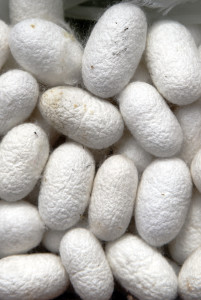 Scaffolds made of silk could give doctors a simple, more effective material for performing bladder augmentation in people with urinary tract defects—to relieve incontinence and prevent kidney damage in children born with small bladders, for example. Rather than using cells to augment the bladder, a complicated process, silk could provide an “off the shelf” option, says Carlos Estrada, MD, a urologist at Boston Children’s Hospital.
Scaffolds made of silk could give doctors a simple, more effective material for performing bladder augmentation in people with urinary tract defects—to relieve incontinence and prevent kidney damage in children born with small bladders, for example. Rather than using cells to augment the bladder, a complicated process, silk could provide an “off the shelf” option, says Carlos Estrada, MD, a urologist at Boston Children’s Hospital.
Recent research by Estrada and Joshua Mauney, PhD, shows that scaffolds made of fibroin (the protein that makes up raw silk) have worked well in augmenting bladders in animal models—without the need for cells.
Estrada and Mauney built on the work of Anthony Atala, MD, who became head of the Institute for Regenerative Medicine at Wake Forest after undertaking pioneer work in tissue engineering in Boston Children’s Urology Department. Atala’s approach to bladder augmentation produced a scaffold from biocompatible materials seeded with cells from diseased bladders, expanded in the laboratory. The “cellularized” scaffold was matured in an incubator for three to four days and then implanted in the body.
While initial results were promising, problems began to emerge with this approach. Cellularization is the most complex part of this strategy, Estrada asserts, and cells taken from diseased bladders “do not always function appropriately.” So instead, Estrada and Mauney sought a new biomaterial that required “no cells at all” to generate tissue.
A new biomaterial
They turned to silk. “Silk is attractive, because it’s a naturally occurring polymer,” Estrada says. Also, silk is “tuneable” and can take on many forms, including foams and weaves. “It can be elastic, porous or stiff—whatever you need.”
For bladder augmentation, he says, “you want a material that will provide physical support initially for the defect site but will gradually be replaced by host tissue over time.”
With this in mind, Estrada, Mauney and their colleagues imported silk worms from Asia, then boiled down the silk to remove the protein sericin, which is immunogenic and could trigger an allergic reaction. What remains is inert and biodegradable, yielding scaffolds that are “strong and elastic but also capable of degrading to allow for tissue regeneration,” Estrada reports.
Together, Mauney and Estrada have produced a novel bi-layer silk scaffold, comprised of a foam layer that allows for ingrowth of host tissues and a non-porous layer that seals the wound site.
For their initial experiments, they placed the scaffolds in rodents with urinary tract defects. “We found that the scaffolds degraded over time while supporting the formation of functional new tissue,” Estrada says. The same was true in larger animals such as pigs.
Beyond the bladder
The researchers are excited to have found “an acellular platform permissive for tissue regeneration,” Estrada says. He hopes the technique will replace the current technique for bladder augmentation, a complex, open procedure in which a portion of the intestine or stomach is attached to the bladder as a patch. Moreover, he sees the new approach as having uses beyond the bladder: “We may be able to use these scaffolds in the urethra, esophagus, trachea—any of the hollow organs.”
In the meantime, Estrada says, the team will further test their scaffold in animals with bladder defects, with the help of a grant from the Boston Children’s Technology and Innovation Development Office (TIDO). They hope that clinical trials on human patients will begin within five years.






